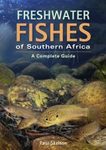![Fishes of the Cross River Basin (Cameroon-Nigeria) Fishes of the Cross River Basin (Cameroon-Nigeria)]()
Click to have a closer look
About this book
Customer reviews
Related titles
About this book
The fish fauna of the Cross river basin has been investigated in detail from contemporary and historical preserved museum collections and the associated scientific literature. Summary descriptions, figures and diagnostic keys are provided to aid identification. Recent fieldwork in the Lower Cross (Nigeria) and the Upper Cross (Cameroon) enables a broader interpretation of the taxonomic results in the context of zoogeography, ecology and conservation. A minimum of 166 species of fish (15 orders, 42 families and 97 genera) occur within the Cross including some undescribed taxa and others which have only recently been described. This well-documented total represents a major advance in our knowledge of the ichthyofauna compared with historical and contemporary estimates, which are off by at least 73%. The Cross (c. 70 000 km2) has 45-55% more fishes than other hydrographically comparable West African river basins which have been fully surveyed. About 33 (20%) fish species from the Cross have marine affinities and may represent an intrusive fauna. Discounting this element, there are still 36-47% more freshwater species in the Cross than in equivalent basins. Siluroids, percoids, characoids, cyprinoids, cypronodontiforms and osteoglossoids form 95% of the fishes. Of 132 freshwater species recognised, at least 11 (8%) are probably endemic; but, on present data, an undue reliance cannot be placed on endemism in zoogeographic analysis.
Long considered to belong to the Lower Guinean ichthyofaunal province, the Cross nevertheless contains – in addition to species recognised from that area – numerous taxa traditionally associated with the Upper Guinean, Nilo-Sudanian and Zairean provinces. This, and the growing phyletic and zoogeographic evidence for trans-continental, inter-continental and even trans-Atlantic alpha-level ichthyofaunal relationships, undermines the integrity of the current closely circumscribed provincial concepts. A provincial zoogeography based on endemism and focussed on recent paleogeography (post Miocene–Pliocene transition, c. 7 m.y. B.P.) is inadequate to explain these wider relationships. A broader time-scale of vicariance events is envisaged which may at least date back to the early Caenozoic or Mesozoic (c. 63-180 m.y. B.P.). The substantial marine intrusive component of the Cross ichthyofauna (and its penetration often far upriver) also raises questions on the extent to which the fresh water fauna is or has been isolated from the sea in terms of current ‘biogeographic island’ concepts. There are also problems over the integrity of the traditional concept of evolutionary cum ecological divisions of "primary" and "secondary" freshwater fishes.
In ecological terms, the large number of Cross species must relate (in a way which is not entirely clear) to the surface area of the basin and its average annual discharge. The Cross was contained within a probable stable paleorefugium of wet tropical forest, and it may well be that it has enjoyed paleo-ecological circumstances comparatively favourable to the maintenance and development of a highly diverse ichthyofauna. Within the Cross basin today there is a longitudinal zonation of species. Several species known from the Upper Cross (which lacks a rainy-season floodplain and aquatic macrophytes) are so far unknown from the Lower Cross (which has a floodplain and well-vegetated areas). The autecology in the Cross (and degree of interspecific overlap in habitat or microhabitat) for speciose genera such as Barbus (Cyprinidae) and Aphyosemion (Cyprinodontidae) are among many aspects which remain to be investigated. However, a small maximum body size (c. 8 cm TL) is a common characteristic of small cyprinids, siluroids, cyprinodonts and characoids in the rainforest streams. Limited data on the trophic biology of Cross species highlights the paucity of primary consumers, the importance of aquatic arthropods in the diet and the fact that allochthonous terrestrial insects are also often eaten. While feeding may take place both during the day and at night, many species show a heightened feeding activity after dusk. From fragmentary data, it seems that a number of fishes breed throughout the year (including the dry season, December–February) but many show peak reproductive activity in the rainy season (July–September). A comparatively low fecundity (dozens, hundreds or a few thousand of eggs versus tens of thousands or millions) appears to be general.
The human factor is critical in determining the past, present and future ecology of the Cross river basin. Prior to 1500 A.D., fishing was among the most important rural activities and a large and economically important artisanal fishery persists to the present day. An adverse human impact on the indigenous fish populations, throug overfishing, was already evident by the early 20th Century. National Rainforest Parks have recently been established in Nigerian and Cameroonian parts of the Cross basin and here, at least, the river remains in a pristine ecological state with flourishing fish communities. Outside of these areas damming, forestry and fisheries projects constitute a growing threat to the aquatic biota, mainly through habitat modification and the translocation of fish species for aquacultural purposes. There is, however, no evidence that current ichthyogeographical patterns can be accounted for through such species transfers.
Customer Reviews






















![Révision des Characidae Nains Africains [Revision of African Dwarf Characidae]](http://mediacdn.nhbs.com/jackets/jackets_resizer_medium/14/148604.jpg?height=150&width=99)

![Les Poissons du Lac Tumba et de la Région d'Ikela: Etude Systématique et Écologique [The Fish of Lake Tumba and the Ikela Region: Systematic and Ecological Study]](http://mediacdn.nhbs.com/jackets/jackets_resizer_medium/14/148546.jpg?height=150&width=100)
![Faune des Poissons d'Eaux Douces de la Réserve de la Biosphère de Dimonika (Mayombe, Congo) [Fauna of the Freshwater Fishes of the Dimonika Biosphere Reserve (Mayombe, Congo)]](http://mediacdn.nhbs.com/jackets/jackets_resizer_medium/14/148793.jpg?height=150&width=107)














![Mongala: Jonction des Territoires et Bastion d'une Identité Supra-Ethnique [Mongala: Junction of Territories and Bastion of a Supra-Ethnic Identity]](http://mediacdn.nhbs.com/jackets/jackets_resizer_medium/25/250908.jpg?height=150&width=106)


![Reptiles Récoltés au Congo par le Dr. H. Schouteden et M. G.-F. de Witte [Reptiles Collected in the Congo by Dr. H. Schouteden and M. G.-F. de Witte]](http://mediacdn.nhbs.com/jackets/jackets_resizer_medium/14/148319.jpg?height=150&width=115)
![Les Poissons des Hauts-Bassins de la Volta [The Fish of the Upper Basin of the Volta]](http://mediacdn.nhbs.com/jackets/jackets_resizer_medium/14/148583.jpg?height=150&width=99)




